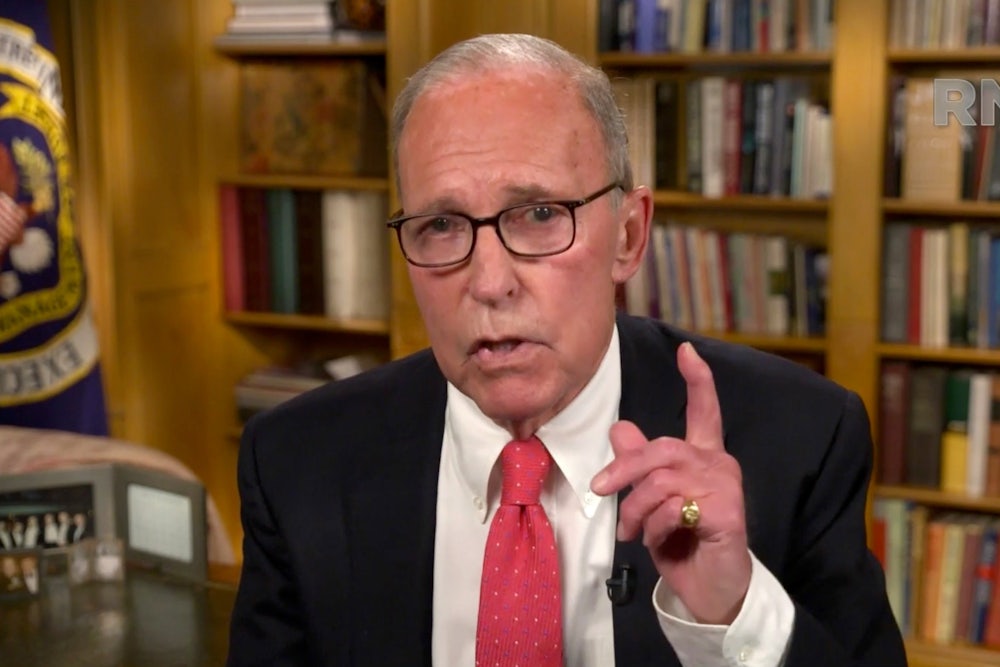Thanks to the Covid-19 lockdown, convention speeches this year are crafted for the camera rather than a crowded exhibition hall, a limitation that makes them seem more intimate. Many commentators saw that as a virtue during the Democratic convention, but you didn’t hear them say that after the Republican convention began. When the camera traded Michelle Obama for Larry Kudlow, what had seemed like a cozy fireside chat now looked more like a late-night infomercial to cure toenail fungus.
Kudlow’s speech aired on Tuesday, but it took me a couple of days to catch up with it. The assignment before Trump’s Fox News–trained director of the National Economic Council was unusually difficult: Defend an economy pushed into severe recession by a pandemic that the Trump administration is mishandling badly. In general, the GOP strategy has been to insist that it isn’t fair to grade Trump on anything that happened after March 1. Kudlow raised the stakes in this already fraught gambit by saying that the pandemic is over and the recovery already begun. That isn’t remotely true.
Kudlow actually began by saying, “Hello folks, you know me from TV and radio,” the classic refrain of the down-on-his-luck former celebrity turned pitchman. He then proclaimed Trump’s economic plan “a roaring success, inheriting a stagnant economy on the front end of a recession.”
But the economy was not stagnant when Trump entered office. It was more than seven years into recovery from the recession that Barack Obama inherited from Trump’s fellow Republican George W. Bush. The only recession that’s occurred since then is the one that started this spring under Trump.
Gross domestic product growth before Covid was about the same on an annualized basis under Trump (2.5 percent) as it was during Obama’s second term (2.3 percent). When Trump’s final year is averaged in, his GDP scorecard will be considerably worse. A better comparison is to match Obama’s last three years to Trump’s first three. By that yardstick, GDP growth under Obama was faster. (So was job growth.)
In the most recent quarter (April–June), GDP fell 32.9 percent—a drop-off not seen since the mid-nineteenth century.
During his two terms, Obama more than halved the unemployment rate, to 4.7 percent. Trump pushed it down a bit further, to 3.5 percent, before the coronavirus hit. Now unemployment is above 10 percent.
The centerpiece of the economic plan that Kudlow called a “roaring success” was a corporate tax cut, which was supposed to spur investment. Instead, investment fell and the manufacturing sector spent 2019 in recession. Growth in nonresidential fixed investment, which had climbed steadily during Obama’s last year in office, stood at 5.4 percent in December 2017, when the tax bill passed. By the end of last year, it had fallen below zero.
Again, this was before the Covid-19 pandemic arrived in the United States. Nonresidential fixed investment has fallen further since then.
“Then,” Kudlow recited in singsong tones, “came a once-in-100-year pandemic. It was awful. Health and economic impacts were tragic. Hardship and heartbreak were everywhere. But presidential leadership came swiftly and effectively, with an extraordinary rescue for health and safety to successfully fight the Covid virus.”
Note the past tense. The number of new Covid-19 cases is down from its peak in July, but it’s still well above where it stood at the end of June. Did you feel safe at the end of June? Then why would you feel safe now? If the Covid crisis is over, then why was Kudlow delivering his speech from his office rather than in a delegate-thronged convention hall?
The notion that Trump showed any “presidential leadership” at all in managing the crisis is too obviously false to refute. A poll late last month said 66 percent of all Americans thought he botched the pandemic.
“With emergency spending and tax cuts,” Kudlow said, “Americans are going back to work.” The toenail fungus of economic misery is gone! Except it isn’t. Unemployment is down from its May high of 13.3 percent, but it’s delusional to say Americans are going back to work when unemployment remains above 10 percent and weekly unemployment claims remain above one million.
Kudlow said the stock market is up, consumer spending is up, and the real estate market is bullish. That’s true, and it’s a little weird. But consumer confidence is at a six-year low, fueled in part by the expiration of the $600 weekly sweetener to unemployment benefits that the Trump administration refuses to extend. Kudlow spoke mystifyingly of a “V-shaped recovery,” as if reciting the words could make it appear.
“Look,” Kudlow concluded, “our economic choice is very clear. Do you want economic health, prosperity, opportunity, and optimism? Or do you want to turn back to the dark days of stagnation, recession, and pessimism?”
Well, obviously we want prosperity, opportunity, and optimism. But let’s get real. That choice isn’t on the menu right now. The “dark days of stagnation, recession, and pessimism” never went away. Breathes there a soul on earth who thinks they did?
